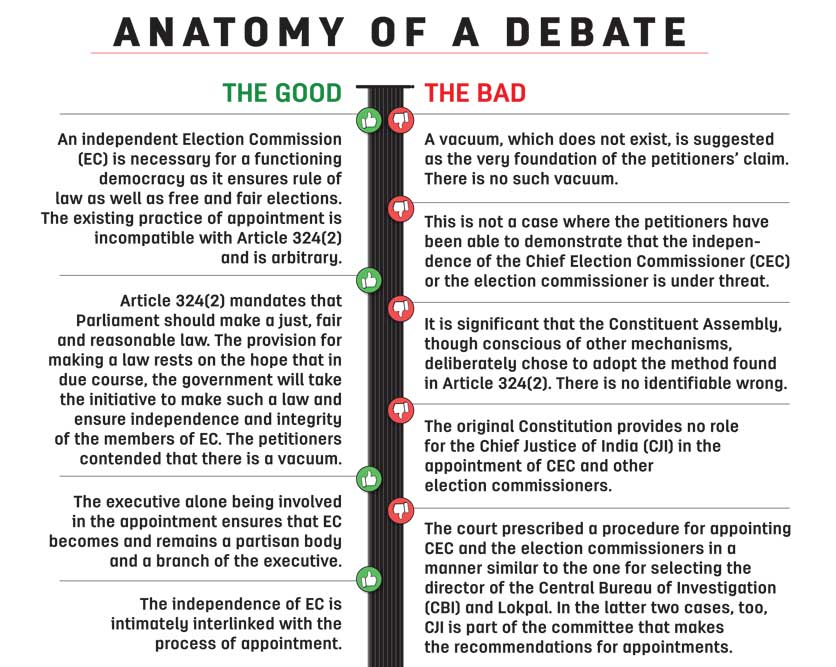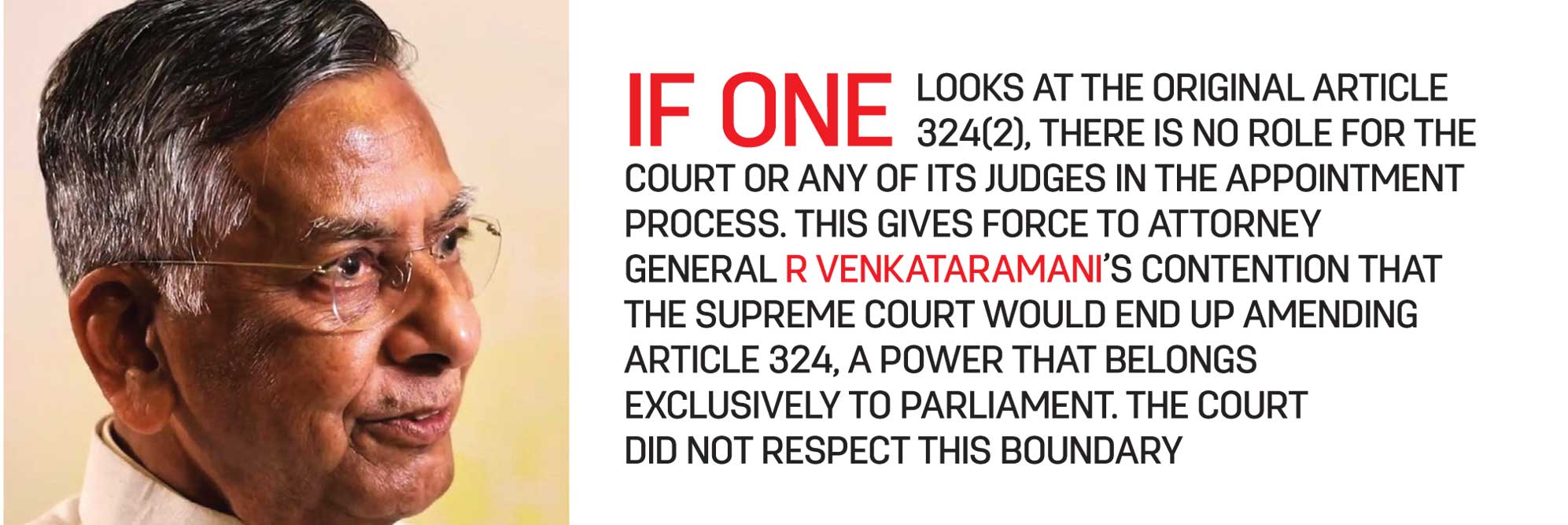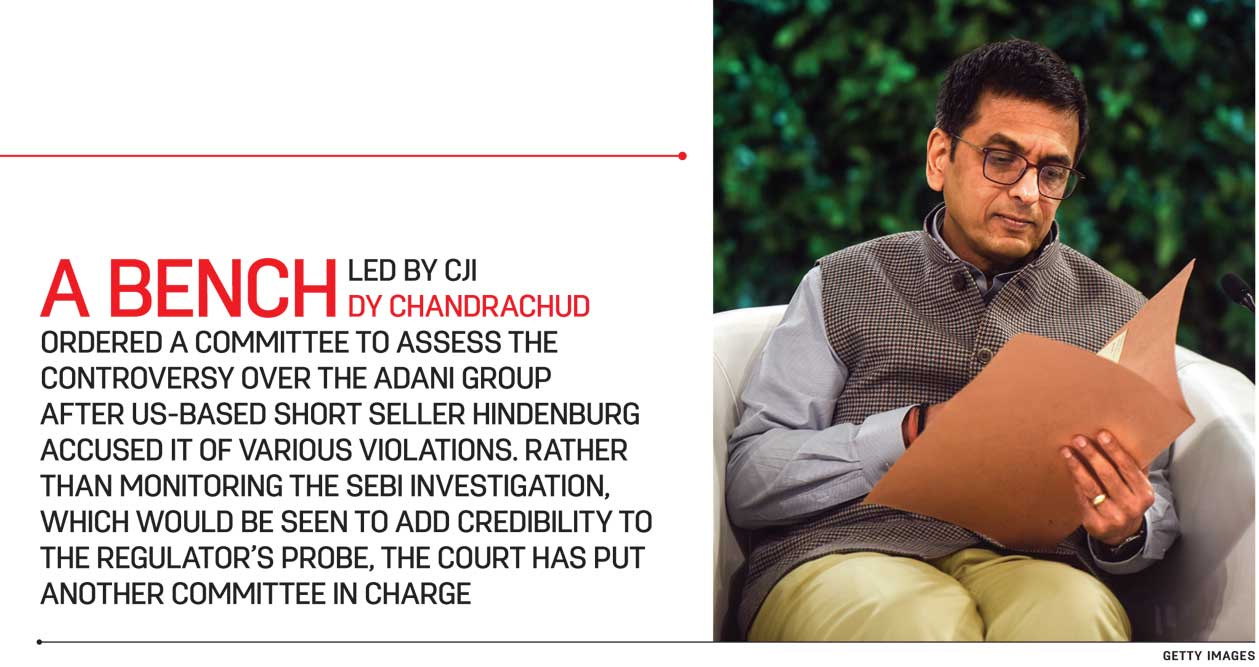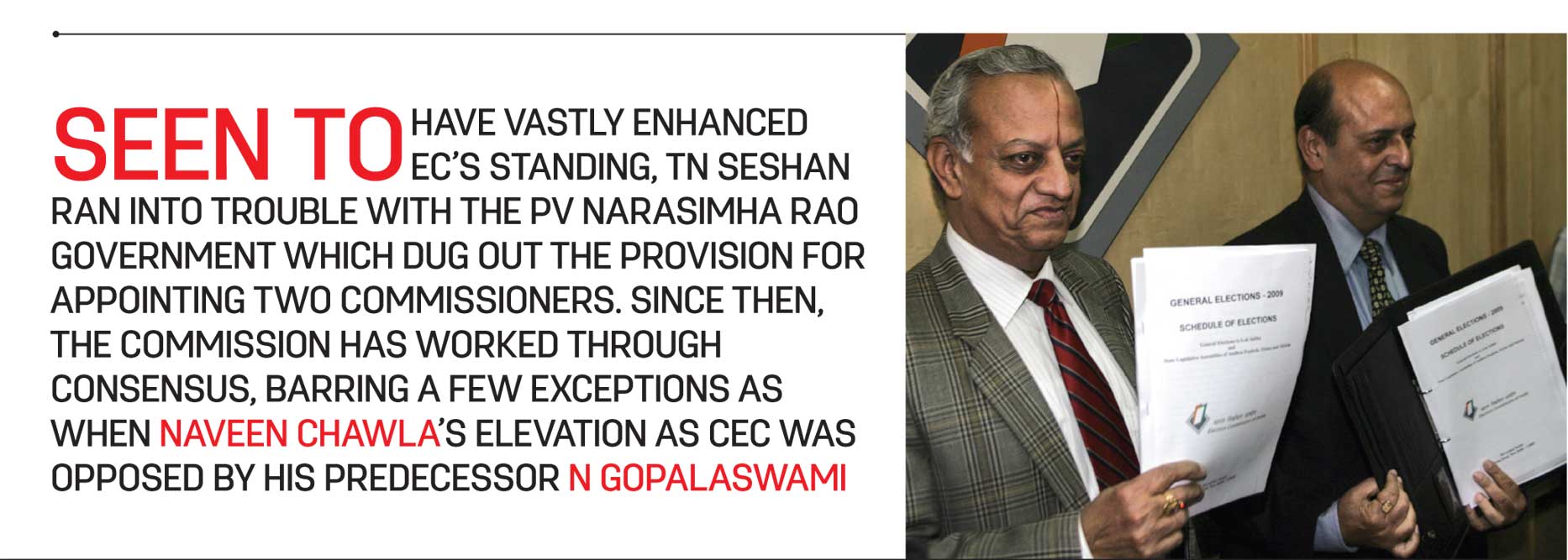Beyond the Brief
Has the Supreme Court overreached by entering the political debate on the Election Commission and the Adani controversy?
 Rajeev Deshpande
Rajeev Deshpande
 Rajeev Deshpande
Rajeev Deshpande
 Siddharth Singh
Siddharth Singh
 |
10 Mar, 2023
|
10 Mar, 2023
/wp-content/uploads/2023/03/Supremecourt1.jpg)
(Illustration: Saurabh Singh)
IN FEBRUARY 2019, Mallikarjun Kharge, current Congress president and then leader of the party in Lok Sabha, wrote a lengthy dissent note opposing the appointment of former Madhya Pradesh police chief RK Shukla as director of the Central Bureau of Investigation (CBI). Kharge said Shukla lacked experience in anti-corruption investigations. As it happened, Kharge had similarly dissented in 2017 when Alok Verma was appointed CBI chief—on the very same grounds, alleging a lack of experience in probing graft cases. Thereafter, when Verma became embroiled in a bitter and very public controversy with his No 2 Rakesh Asthana and was finally removed from his post, Kharge dissented yet again, this time saying the officer should be allowed to respond to allegations of wrongdoing. Responding to Kharge’s repeated dissensions, then-Finance Minister Arun Jaitley wrote that the Congress leader dissented at every conceivable opportunity. “He uses the weapon of dissent excessively and not objectively. Using the instrument of dissent recklessly neutralizes its value,” Jaitley had written in a blog post.
During his tenure as a member of the selection committee for the CBI chief, Kharge dissented most of the time and decisions were taken on the basis of the concurring views of Prime Minister Narendra Modi and the Chief Justice of India (CJI). The fractious nature of present-day politics and the high levels of animosity between the Gandhis and the Bharatiya Janata Party (BJP) brass (further fuelled by anti-corruption investigations into the affairs of Sonia Gandhi’s son-in-law Robert Vadra) made the selection committee’s deliberations utterly predictable. At the time he opposed Verma’s removal from CBI, Kharge was a petitioner in the Supreme Court in the case involving the head of the agency. “The only task before the selection committee was whether the CVC report contains adequate material for transfer of the director or not. He (Kharge) wanted the committee to either ignore the CVC report or sit in appeal against the finding of the CVC—something beyond the jurisdiction of the Committee,” Jaitley said. Read against the backdrop of the path of confrontationist politics taken by Congress, it is no surprise that Kharge was never on the same page with the government in matters of selection and, in Verma’s case, removal. There are similar committees to select the Chief Vigilance Commissioner (CVC) and vigilance commissioners, head of the National Human Rights Commission (NHRC) and its members, the Central Information Commissioner (CIC) and Information Commission members and the head of Lokpal and its members. When Adhir Ranjan Chowdhury succeeded Kharge as the leader of Congress in Lok Sabha, he too dissented on the procedures for selection of the next CBI chief. Similarly, Chowdhury objected to the appointments to CVC and CIC, claiming at times “fatal infirmities” in the search committee set up to shortlist candidates. Kharge who, after the 2019 Lok Sabha polls, became leader of the opposition in Rajya Sabha, objected to the appointment of Justice Arun Mishra as head of NHRC. As member of the selection committee, Kharge said a person from the Scheduled Castes or Tribes be made head of NHRC in the light of a “rise in atrocities” against these sections of society. Once again, the political script was evident as Congress and critics of the Modi government have often claimed that violence against disadvantaged sections has risen during BJP’s tenure in office. BJP has countered the charge, pointing out that various states are governed by different political parties and that law and order is a state subject. It has also referred to national crime data to say that no such definitive patterns are discernible. But facts of the case are hardly the issue as the proceedings of the selection committees are essentially an extension of political battles.
On March 3, despite the pile of evidence that the selection committees for sensitive posts are providing neither transparency nor thoroughness to the appointments—rather their proceedings replicate the very political partisanship the panels were intended to avoid—a Supreme Court Bench headed by Justice KM Joseph chose just such a method to institute a new selection process for the Chief Election Commissioner (CEC) and the two election commissioners. The Bench ruled that appointments to the Election Commission (EC) will be made by a panel comprising the prime minister, leader of the opposition, and CJI. It also said the two election commissioners will be on a par with CEC. While delivering its judgment, the Supreme Court has lent on scenarios that it felt could undercut the functioning of democracy, arguing that an election commissioner must be independent and therefore unbiased. Such a person will “[hold] the scales evenly, even in the stormiest of times, not being servile to the powerful, but coming to the rescue of the weak and the wronged, who are otherwise right…” It also notes that a “brute majority” generated by a democratic process must comply with constitutional safeguards and that while majoritarian forces might be compatible with democracy, they must be counterbalanced with protection to those who are not in majority. It further states that an unrelenting abuse of the electoral process over time is the surest way to the “grave” of democracy. A selection panel would, in the views of the court, help prevent a pliable EC that could be a gateway to “the acquisition and retention of power”. Criticising the role of the government in appointing CEC and election commissioners, the Bench said, “The demand for putting in place safeguards to end the pernicious effects of the exclusive power being vested with the Executive to make appointment to the election commission, has been the demand of political parties across the board.” It is another matter that no political party when in office has moved to remove or dilute the role of the government in appointments to EC.

The Supreme Court’s ruling on EC has predictably generated contrasting opinions, often coloured by the political stance of commentators. A reading of the order, apart from raising doubts about the utility of a process marred by political contestation, also has serious implications relating to the separation of powers envisaged in the Constitution. The Bench effectively rewrote Article 324 of the Constitution that provides for appointment of CEC and election commissioners by ordering that until Parliament frames a law for appointing them, the president will make these appointments on the advice of a committee. In Article 324 as it stands now, there is no role for CJI in these appointments. Another order by the court, issued on the same day, again indicated the judiciary’s eagerness to wade into issues that might require more restraint. A Bench led by CJI DY Chandrachud ordered a committee to assess the recent controversy over the Adani Group after US-based short seller Hindenburg accused it of various violations. The court’s committee to examine possible regulatory failures comes at a time when the volatility in the securities market is being examined by the Securities and Exchange Board of India (SEBI). Rather than monitoring the SEBI investigation, a process that would be seen to add credibility to the regulator’s probe, the court has put a committee in charge of the entire matter. At the same time, it is unclear whether and how the committee will examine allegations about Hindenburg’s functioning given that its report on Adani businesses has several sweeping political statements about the group holding back India’s progress and the allegedly “broken” state of the country’s capital markets. The Supreme Court-appointed committee has retired judges and bankers and private experts but oddly enough no one from SEBI or even the agencies that investigate economic crimes.
Senior advocate Rakesh Dwivedy points to the anxieties, or worst-case scenarios that seem to underpin the court’s order. “I would have to respectfully differ on whether EC has failed to function effectively. It is often the losing parties that have claimed bias. They have raised questions over the electronic voting machines. But these complaints are not aired when these parties win the election. In the EC case, the court has exercised its powers in the context of Article 324 itself but some of the assumptions do not appear to be correct,” he said. Dwivedy feels that a selection committee intended to bring about greater transparency is not in itself objectionable but points to the stalemates in the proceedings of such panels. On whether the government should bring in a law that could amend the court’s ruling, the lawyer said this was always possible even if marked by political oneupmanship. “This is not going to change and cannot be a reason for not bringing a law,” he added. On the court order in the Adani case, Dwivedy wondered if the court had jumped the gun and felt the ongoing SEBI investigation should not be junked. He also pointed to the risk that continuing uncertainty might affect the decisions of financial institutions and raise doubts about the stability of the stock market. The court’s ruling does come in the backdrop of a political slugfest with Congress and other opposition parties raising questions about the exposure of the Life Insurance Corporation (LIC) and the State Bank of India (SBI) to Adani businesses.

Any amendment to the Constitution is the sole prerogative of Parliament from its initiation onwards. Its final stamp of approval comes with the president signing the amendment into law. With the EC judgment, this process has become subject to ‘negotiation’ with the judiciary. In its judgment, the court said, “The theory that the courts cannot or do not make laws is a myth which has been exploded a long while ago.” At the same time, the court said, “[I]t is not open to the legislature to don the robes of a Judge and arrogate to itself the judicial function.” The government-judiciary tussle is very much in discussion over the court’s refusal to consider any dilution in the judicial control on appointments to the high courts and the Supreme Court. This asymmetric formulation lies at the heart of the court’s encroachment on the legislative and executive domains. The cases revolve around a clutch of petitions brought forward by ‘activist lawyers’ that say the electoral process is in peril as the executive has the sole say in appointing CEC and election commissioners. The court agreed with this contention, much against the protestations of Attorney-General for India (AG) R Venkataramani. The AG argued that if the petitions were accepted it would amount to an amendment of Article 324. The AG also said there was no vacuum in the appointment process as was suggested in the petitions. The core of his argument was: “judicial intervention in these matters would be at the expense of causing violence to the delicate separation of powers between the Legislature, the Executive and the Judiciary.” The top law officer argued in vain that the hunt for a seemingly ideal solution should not be the cause for judicial intervention and it was incorrect to conclude, as the petitioners argued, that the electoral system was broken or beset with serious infirmities. Just days after the Supreme Court ruling on EC, the results to three elections in the Northeast were declared, bringing to conclusion hard-fought campaigns. A fledgling party emerged in second place in Tripura and Meghalaya returned a chief minister with whom BJP had parted ways. Millions of votes were counted smoothly in a day, unlike the prolonged counting witnessed in the US national election. It is the Supreme Court itself which has on several occasions upheld EC’s powers and thrown out politically motivated challenges to replacing the electronic voting machines (EVMs) with obsolete paper ballots.

The court did not accept the AG’s contention. Instead, relying on debates in the Constituent Assembly and an expansive reading of the ‘meaning’ of Article 324, the court ruled that the framers had not envisaged giving such wide powers to the executive. Even more worryingly, the court somehow assumed that this power being the sole preserve of the executive is unacceptable and bound to be misused. The court said, “With the accumulation of wealth and emergence of near monopolies or duopolies and the rise of certain sections in the media, the propensity for the electoral process to be afflicted with the vice of wholly unfair means being overlooked by those who are the guardians of the rights of the citizenry as declared by this court would spell disastrous consequences.” The court also said the powers of EC were too wide-ranging for the appointments to be in the hands of the executive exclusively. Some of the argumentation seems to echo current political debates where BJP’s opponents and a section of the commentariat have claimed that India is becoming an “electoral autocracy”, a term used in tandem with “democratic backsliding”. External Affairs Minister S Jaishankar responded to the reports of organisations like Freedom House and V Dem, amplified by the opposition. “You use the dichotomy of democracy and autocracy. You want the truthful answer… it is called hypocrisy. Because you have a set of self-appointed custodians of the world, who find it very difficult to stomach that somebody in India is not looking for their approval, is not willing to play the game they want to be played,” he told news agency ANI and added, “So they invent their rules, their parameters, they pass their judgments and then make out as though this is some kind of global exercise.”
The trouble with the court’s judgment is that it is largely based on anxiety that something may go wrong and not on the basis of actual and repeated abuse of the electoral process at the hands of election commissioners. There was no evidence to show that this was the case. The court alluded to a number of issues in electoral politics, from the use of money power to even the criminalisation of politics. These are real issues but their link with some alleged flaws in the appointment process is tenuous to the point of being non-existent. But this did not stop the court. At the heart of the court’s reasoning is the wording of Article 324(2). The article describes the composition of EC and the appointment of the election commissioners. These, the article says, “shall, subject to the provisions of any law made in that behalf by Parliament be made by the President.” The court ruled that the meaning of the part “subject to the provisions of any law made in that behalf by Parliament” implied that this power was not to belong exclusively to the executive. The court admits the provision is not a compulsion on the executive but bases its intervention on the invocation about Parliament framing a law. The EC website itself lists its recommendations, such as an independent secretariat with funds drawn directly from the Consolidated Fund of India. Though CECs have spoken of a selection panel, usually after demitting office, this is not a formal demand from EC. In the past, committees like the Justice Venkatachaliah Commission in 2002 had suggested a collegium for appointments to EC. The apex court has also called for long tenures but did not pass an order on the subject. But lengthy tenures might well become a problem in the event of a wrong choice. Seen to have vastly enhanced EC’s standing, TN Seshan ran into trouble with the PV Narasimha Rao government which dug out the provision for appointing two commissioners. Seshan was then involved in unending scraps with his new colleagues but since then, the commission has more or less worked through consensus, barring a few exceptions as when Naveen Chawla’s elevation as CEC was opposed by his predecessor N Gopalaswami on the grounds of partisan functioning. Then-President Pratibha Patil had rejected the plea which did not find favour with the Manmohan Singh government. EC’s functioning, it is pointed out, is subject to the scrutiny of opposition parties at various stages, such as when voting happens, EVMs are stored in strong rooms, and ballots are counted. Some commentators point to a perceived reluctance to pull up senior government figures for violations of the model code of conduct. Here too, EC’s powers are mostly limited to censure and imposing a period of silence. Almost all decisions, including allocating the party symbols in case of splits, can be challenged in courts.

The court’s wide reading is at odds with the historical working of EC since the first General Election in 1952. Since then, there has been no law that formally outlines the appointment process: the Constitution is sufficiently clear on that. The president is to appoint CEC and the election commissioners on the recommendation of the government. There have been few controversies with the appointments process. There have indeed been problems in many elections, such as looting of ballot boxes, violence during polling, and other issues. But over time, the incidence of these problems has gone down. The court itself has given aid to EC by requiring that candidates declare their assets and pending criminal cases. This has done much to cleanse the electoral process. Also EC has asserted its control of the administrative machinery at the time of elections, keeping officials on their toes. The most problematic part of the court’s reasoning, however, is the assumption that the executive will tend to manipulate institutions and if left unchecked, will damage democracy. A key source of the executive’s coherence is the presence or absence of legislative majority in Parliament. From 1989 to 2014, a historic reversal of sorts took place when fragmented electoral verdicts necessitated coalition governments often marked by poor governance and corruption cases. The executive was, automatically, weakened. But this was due to the express will of Indian voters and did not require any judicial intervention. If anything, judicial intervention increased during the phase when the executive was weak. This was also the time multiple insurgencies and disturbances hammered India and the government of the day found it hard to take decisive steps.
The court also reasoned that no political party or government wants to take the steps “envisaged” in Article 324(2), namely, give legislative backing to the appointment process. It says no government or political party wants to do this. This comes close to questioning the legitimacy of the political and democratic processes. If such a law were indeed found to be necessary, there was plenty of time between 1952 and 2014 for the legislature in its wisdom to craft one. If the framers of the Constitution wanted such a law, they would have explicitly said so. The Constituent Assembly had exceptionally thoughtful members and many trained barristers and jurists. They would not have left such an important part of the Constitution to the interpretative mercies of men and women seven decades later.

Perhaps the most vexing part of the court’s prescription is to include CJI in the committee that is to make recommendations to the president. The court arrived at this by equating the appointments process for CEC and the election commissioners with those for the CBI director and Lokpal (under the Lokpal and Lokayuktas Act, 2013). In those processes, CJI is part of the recommending process. But why should CJI be part of the committee to make the recommendation for appointing CEC and the election commissioners? The court did not answer the question specifically except to blandly assert that the committee should have the prime minister, leader of the opposition (or the leader of the single-largest opposition party) and CJI. The absence of any reasoning for this is troubling.
If one looks at the original Article 324(2), there is no role for the court or any of its judges in the appointment process. This gives force to the AG’s contention that the Supreme Court would end up amending Article 324, a power that belongs exclusively to Parliament acting in its constituent function. The court did not respect this boundary. A judicial creep and interference in the domains of executive and legislature might be just as worrisome as the court’s fears that the executive could end up damaging democracy. But it paid little heed to such a possibility with an order that could make the appointments process to EC—a role model for other nations for its expertise in conducting elections on an unprecedented scale—much more fraught and open to contentious politics. So far, there has been no reaction from the government to the court’s decision, but it is learnt that it may not take any immediate step. It is important for government and Parliament to step in and preserve the separation of powers before the fabric of the Constitution is eroded further by the court’s seeming overreach.

/wp-content/uploads/2025/06/Cover-OpenMinds2025.jpg)










More Columns
Puri Marks Sixth Major Stampede of The Year Open
Under the sunlit skies, in the city of Copernicus Sabin Iqbal
EC uploads Bihar’s 2003 electoral roll to ease document submission Open